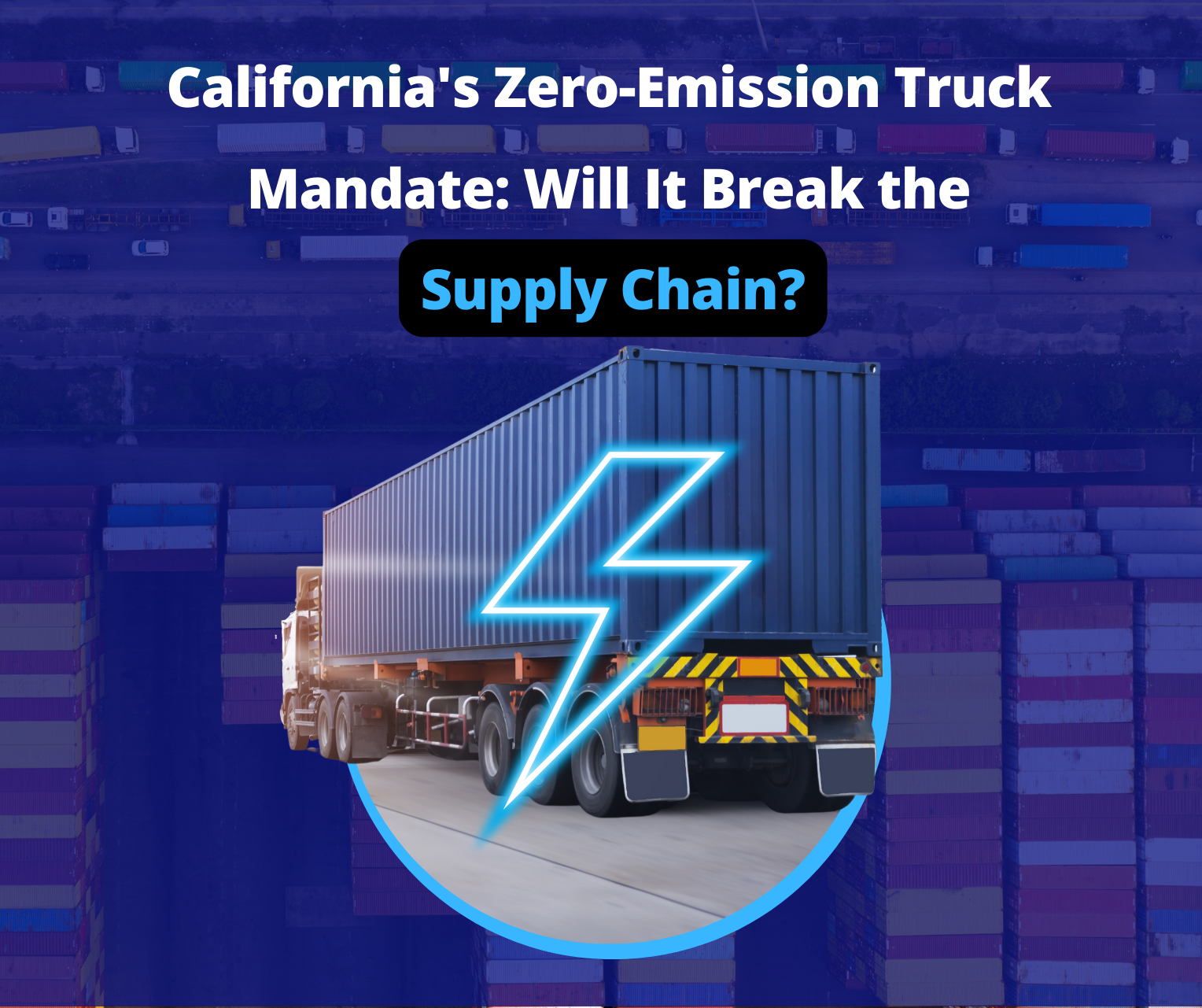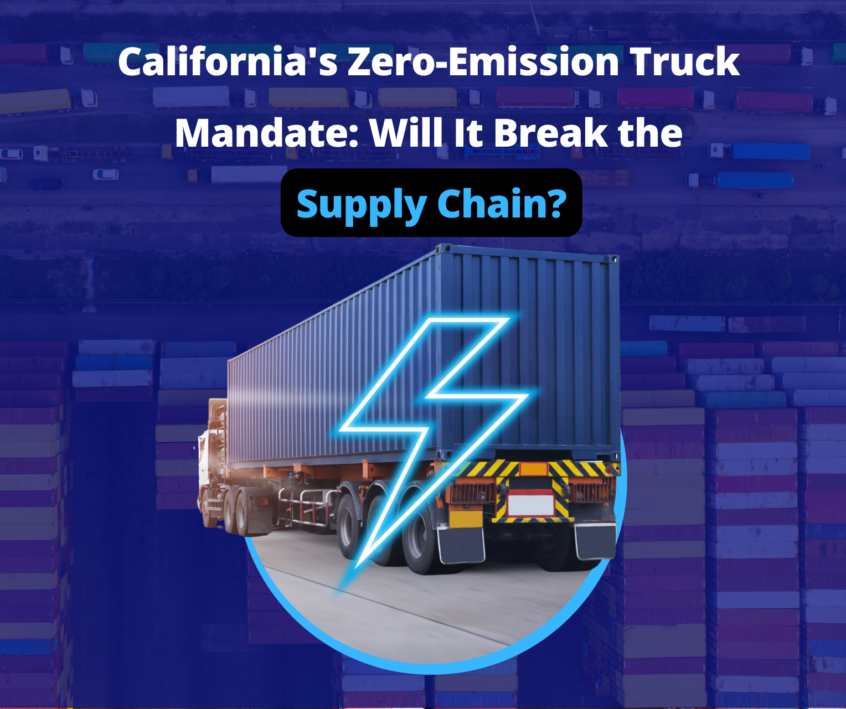
Navigating the treacherous road ahead
California, often at the forefront of progressive environmental policies, is once again blazing a trail with potential to reshape the American trucking industry. As the state seeks to electrify its trucking fleets, we stand on the precipice of a significant transition. On one side lies the promise of cleaner, greener logistics, and on the other, there is potential chaos that could disrupt the supply chain.
The California Air Resources Board (CARB) has set forth a bold mandate, requiring a drayage of fleets working in the bustling ports of Los Angeles and Long Beach, to exclusively purchase zero-emission trucks starting from January 1, 2024. By 2035, these fleets must be entirely zero-emission, a monumental shift that could revolutionize the trucking industry. However, the road to a fully electrified fleet is fraught with uncertainty and challenges.
In this article, we will explore the consequences of California’s latest environmental regulation on truckers, trucking companies, and the wider logistics industry. We will delve into the preparations, the challenges, and the concerns of this transition. The implications of this move reach beyond state lines, setting a precedent that other regions may soon follow. But will it be a smooth ride—or are there potholes and roadblocks ahead?
Trucking and California’s Ports: A Symbiotic Relationship
Before we dive into the challenges of electrification, let’s first understand the importance of the trucking industry in California, particularly in Los Angeles and Long Beach ports.
These ports handle over a third of all containerized imports to the United States, making them the lifeblood of the nation’s consumer economy. Everything from electronics to clothing to frozen shrimp passes through these ports, contributing hundreds of billions of dollars in trade.
Containerization in the 1950s revolutionized the shipping industry, making it significantly more efficient. This led to a boom in trade and economic growth. Today, these ports support one in nine jobs in their surrounding counties, showcasing their vital role in the region’s prosperity. However, this success story has a dark side.
The Environmental Toll: Toxic Emissions & Health Consequences
While these ports drive economic growth, they also leave a trail of environmental damage and health issues. The residents of southwestern Los Angeles County, in particular, endure more frequent asthma attacks and significantly higher cancer rates due to toxic air pollutants. Diesel exhaust from trucks, trains, and ships, coupled with other carcinogenic air pollutants, are primarily to blame for this dire health situation.
The emissions from idling ships during the supply chain crisis in 2020 and 2021 further aggravated the problem, as the exhaust was equivalent to what 100,000 diesel trucks would emit. In Wilmington, a town near the ports that witnesses constant truck traffic, the noise and pollution have severely disrupted the quality of life for its predominantly low- to middle-income residents.
Electric Trucks: The Solution or a New Challenge?
The solution to this environmental crisis, at least in theory, is the adoption of electric big rigs. These electric vehicles (EVs) produce significantly fewer greenhouse gas emissions over their lifetimes than traditional diesel trucks. It’s a viable, albeit imperfect, alternative to diesel-powered trucks.
Electric big rigs in the USA have gained significant attention due to their potential merits and demerits. On the merit side, these vehicles offer a promising solution to reducing greenhouse gas emissions and combating climate change. With zero tailpipe emissions, electric big rigs can contribute to improved air quality and reduced noise pollution, especially in urban areas. Additionally, electric trucks have the potential to significantly reduce operating costs, as they generally have lower fuel and maintenance expenses compared to their diesel-powered counterparts. Moreover, the growing availability of charging infrastructure throughout the USA helps alleviate range anxiety, making electric big rigs a viable alternative for long-haul transportation.
Nevertheless, there are also some notable demerits. Currently, there are concerns over the limited range of electric big rigs, making them less ideal for exceptionally long distances or remote locations lacking charging infrastructure. Additionally, the high initial cost of electric trucks poses a significant challenge for widespread adoption within the industry. Moreover, battery technology limitations necessitate longer charging periods, impacting productivity and efficiency. While electric big rigs show promise, further advancements in technology, increased infrastructure development, and considerations of cost-effective solutions are crucial in overcoming these hurdles and maximizing the benefits they offer.
Charging Infrastructure: A Missing Link
California has seemingly fallen on the side of supporting electric big rigs as an environmental protection measure. To accelerate this transition, CARB has mandated that drayage fleets register their trucks in an online database by December 31. New trucks registered after January 1, 2024, must be zero-emission, and by 2035, all drayage trucks must be zero-emission. However, here’s where the road ahead becomes challenging.
The success of electric trucks hinges on the availability of efficient charging infrastructure. Yet, several months before the regulation’s enforcement, there’s uncertainty about where these electric trucks will be charged. Approximately half of drayage truck drivers park their vehicles overnight at trucking company sites, which could allow for overnight charging.
Utility providers like Southern California Edison (SCE) are working to provide charging portals for medium- and heavy-duty trucks. Still, the urgency and enormity of the task are apparent. SCE has plans to add some 80 gigawatts of power to meet California’s zero-emission vehicle electrification goals, and this doesn’t happen overnight. Trucking industry experts remain skeptical, and trucking companies foresee significant challenges in the months to come.
The Financial Hurdle: Costs & Rates
Another critical concern is the financial aspect. Electric big rigs come with a higher price tag than traditional diesel trucks. While California offers various grants and loan programs to help fleets purchase these vehicles, participating in such programs can potentially lead to tax penalties. An electric drayage vehicle can cost from $350,000 to $400,000, but rebates can help offset these costs. Charging time is another financial and operational concern.
Charging an electric truck takes significantly longer than refueling a diesel vehicle. Electric trucks may require hours to charge, making them less efficient for drayage operations, often involving tight schedules. Electric trucks are also heavier, impacting the amount of freight they can carry, potentially leading to higher shipping rates and, ultimately, increased consumer prices.
The financial hurdle of mandating electric big rigs in California is a significant concern. While these vehicles offer environmental benefits, the costs and rates associated with their implementation pose challenges. According to a study conducted by the North American Council for Freight Efficiency (NACFE), electric big rigs are currently estimated to be $150,000 to $250,000 more expensive than their diesel counterparts. This cost disparity is primarily due to the high price of battery packs, which account for a substantial proportion of the vehicle’s overall expense. Furthermore, the study suggests that the operating cost of electric big rigs is also higher, with electricity prices in California being nearly double that of diesel fuel per mile. This disparity is partly driven by Time-Of-Use (TOU) rates, which charge higher prices during peak demand periods when most charging is likely to occur.
Moreover, the limited lifespan of batteries adds further financial burden, as they require replacement after a certain number of cycles, which can cost around $100,000. These financial challenges are particularly burdensome for independent owner-operators and small fleets, who may struggle to afford the high upfront costs and navigate the complex charging rate structures. Incentives and subsidies are crucial to overcome this hurdle.
California’s Hybrid and Zero-Emission Truck and Bus Voucher Incentive Project (California’s Hybrid and Zero-Emission Truck), for example, provides funding to help offset the higher upfront costs of electric trucks. Additionally, the state’s Low Carbon Fuel Standard (LCFS) program rewards fleet operators for using low-carbon fuels, including electricity, which can help offset the higher electricity cost. By addressing the financial challenges associated with electric big rigs, California can pave the way for a more sustainable and economically feasible transition to cleaner transportation.
An Uncertain Future: Potential Consequences & a Changing Landscape
The implications of California’s environmental regulation are far-reaching. If the transition to electric trucks faces insurmountable challenges, the consequences could be severe. This may cause companies to double their fleet size to maintain current freight levels, driving up costs and causing bankruptcies within the industry. Moreover, it could prompt large retail firms to divert their freight to East Coast ports with less stringent environmental regulations, further shifting the dynamics of trade in the country.
This transition may trigger a domino effect, as other states may follow California’s lead, necessitating similar changes in the trucking industry nationwide. The transition to electric trucks presents the trucking industry with a complex dilemma. Therefore, the industry must navigate environmental concerns, financial challenges, and regulatory demands while ensuring the well-being of truck drivers. As this transition unfolds, one thing is clear: California is setting a precedent that will influence environmental and logistical policies across the United States.
Wrapping Up
California’s latest environmental regulation marks a significant juncture in the evolution of the trucking industry. While it holds the promise of greener and cleaner logistics, it also raises questions about the feasibility of a rapid transition to electric big rigs. The success of this endeavor hinges on the availability of charging infrastructure, the financial implications for trucking companies, and the ultimate impact on consumers. The challenges are substantial, but so are the potential benefits. Electric trucks can significantly reduce emissions and contribute to a more sustainable future.
The decisions made in California will undoubtedly influence other states and regions as the industry grapples with the changing logistics landscape. As we move forward, one thing is certain: The road to a more sustainable trucking industry is filled with twists and turns, and the consequences of this journey will be felt far beyond the Golden State’s borders.



